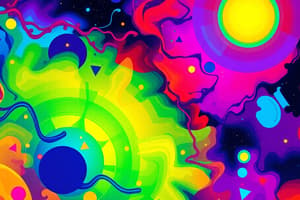Podcast
Questions and Answers
What was the significance of Joseph von Fraunhofer's work with the spectroscope?
What was the significance of Joseph von Fraunhofer's work with the spectroscope?
- He created the first telescope.
- He observed the solar spectrum and mapping dark lines. (correct)
- He invented the prism.
- He discovered that sunlight is made of only one color.
Spectroscopy is the study of the colors emitted by different elements.
Spectroscopy is the study of the colors emitted by different elements.
True (A)
Who discovered that different elements produce unique spectral patterns?
Who discovered that different elements produce unique spectral patterns?
Gustav Kirchoff and Robert Bunsen
A device that produces a focused spectrum is called a ______.
A device that produces a focused spectrum is called a ______.
Match the following elements with the colors they produce when heated to incandescence:
Match the following elements with the colors they produce when heated to incandescence:
What type of light did Isaac Newton use in his experiment?
What type of light did Isaac Newton use in his experiment?
The spectrum produced by heating elements shows all colors of the rainbow equally.
The spectrum produced by heating elements shows all colors of the rainbow equally.
What did Fraunhofer's spectroscope reveal in the solar spectrum?
What did Fraunhofer's spectroscope reveal in the solar spectrum?
_______ is the study of spectra and is related to chemical analysis.
_______ is the study of spectra and is related to chemical analysis.
Which famous experiment demonstrated that sunlight is made of all colors?
Which famous experiment demonstrated that sunlight is made of all colors?
What type of spectrum consists of bright lines on a black background?
What type of spectrum consists of bright lines on a black background?
A continuous spectrum contains distinct colors that are separate from one another.
A continuous spectrum contains distinct colors that are separate from one another.
What can be inferred about moonlight based on Fraunhofer's discovery?
What can be inferred about moonlight based on Fraunhofer's discovery?
The three types of spectra are emission, __________, and absorption.
The three types of spectra are emission, __________, and absorption.
What does an absorption or dark line spectrum indicate?
What does an absorption or dark line spectrum indicate?
Match the type of spectrum with its description:
Match the type of spectrum with its description:
Which elements can be identified in the sun's spectrum based on spectral lines?
Which elements can be identified in the sun's spectrum based on spectral lines?
A diffraction grating provides less detail in a spectrum than a prism.
A diffraction grating provides less detail in a spectrum than a prism.
The __________ effect occurs when light waves bend around corners and pass through each other.
The __________ effect occurs when light waves bend around corners and pass through each other.
Which element is used as an example in the bright line spectrum?
Which element is used as an example in the bright line spectrum?
Which of the following statements describes the function of a spectroscope?
Which of the following statements describes the function of a spectroscope?
A red shift in a star's spectrum indicates that the star is moving away from Earth.
A red shift in a star's spectrum indicates that the star is moving away from Earth.
How can astronomers infer a star's composition?
How can astronomers infer a star's composition?
The Doppler effect causes changes in the __________ of light waves from moving stars.
The Doppler effect causes changes in the __________ of light waves from moving stars.
Match the following terms with their descriptions:
Match the following terms with their descriptions:
What type of spectrum will a heated glow wire produce?
What type of spectrum will a heated glow wire produce?
The composition of the Moon can be inferred using spectroscopic analysis.
The composition of the Moon can be inferred using spectroscopic analysis.
What does it mean if spectral lines from a star appear shifted toward the blue end of the spectrum?
What does it mean if spectral lines from a star appear shifted toward the blue end of the spectrum?
The __________ principle explains the phenomenon where sound waves change pitch as a vehicle approaches or moves away.
The __________ principle explains the phenomenon where sound waves change pitch as a vehicle approaches or moves away.
Which mystery star's spectral pattern shows the greatest difference from that of the Sun?
Which mystery star's spectral pattern shows the greatest difference from that of the Sun?
Flashcards
What is a spectroscope?
What is a spectroscope?
A device that uses a prism to split light into its different colors, revealing dark lines called spectral lines.
What are spectral lines?
What are spectral lines?
Dark lines observed in a spectrum, which are unique to each element.
What is spectroscopy?
What is spectroscopy?
The science of studying spectra, i.e., the different colors of light emitted or absorbed by substances.
What is a spectrum?
What is a spectrum?
Signup and view all the flashcards
What did Newton's experiment show about sunlight?
What did Newton's experiment show about sunlight?
Signup and view all the flashcards
How do spectral lines help identify elements?
How do spectral lines help identify elements?
Signup and view all the flashcards
What is incandescence?
What is incandescence?
Signup and view all the flashcards
What did Fraunhofer observe in the Sun's spectrum?
What did Fraunhofer observe in the Sun's spectrum?
Signup and view all the flashcards
How did Kirchoff and Bunsen contribute to spectroscopy?
How did Kirchoff and Bunsen contribute to spectroscopy?
Signup and view all the flashcards
What is spectroscopy, in simpler terms?
What is spectroscopy, in simpler terms?
Signup and view all the flashcards
What is an emission or bright line spectrum?
What is an emission or bright line spectrum?
Signup and view all the flashcards
What is a continuous spectrum?
What is a continuous spectrum?
Signup and view all the flashcards
What is an absorption or dark line spectrum?
What is an absorption or dark line spectrum?
Signup and view all the flashcards
What is a diffraction grating?
What is a diffraction grating?
Signup and view all the flashcards
What is a spectral fingerprint?
What is a spectral fingerprint?
Signup and view all the flashcards
What is spectral analysis?
What is spectral analysis?
Signup and view all the flashcards
Why are there dark lines in the Sun's spectrum?
Why are there dark lines in the Sun's spectrum?
Signup and view all the flashcards
How do astronomers use spectral analysis to study stars?
How do astronomers use spectral analysis to study stars?
Signup and view all the flashcards
What are the applications of spectral analysis in astronomy?
What are the applications of spectral analysis in astronomy?
Signup and view all the flashcards
What is a blue shift?
What is a blue shift?
Signup and view all the flashcards
What is a red shift?
What is a red shift?
Signup and view all the flashcards
What is the Doppler effect?
What is the Doppler effect?
Signup and view all the flashcards
How can astronomers infer a star's composition?
How can astronomers infer a star's composition?
Signup and view all the flashcards
What should the Moon's spectrum look like?
What should the Moon's spectrum look like?
Signup and view all the flashcards
Which light wave has shorter wavelengths?
Which light wave has shorter wavelengths?
Signup and view all the flashcards
Study Notes
Spectroscopes and Light
- Spectroscopes are devices that produce focussed spectra of light, crucial for studying stars. Early astronomers used them to analyze the light from stars, uncovering their composition.
- Fraunhofer's spectroscope observed dark lines (spectral lines) in the Sun's spectrum. He mapped these lines and later scientists discovered their significance.
Spectral Lines and Elements
- Sunlight, when passed through a prism, reveals a spectrum of colors.
- Spectral lines are dark lines in a spectrum, specific to each element.
- Heating elements produces unique bright-line spectra (emission spectra).
- Passing light through a cooler gas creates absorption spectra (dark-line spectra).
- The unique patterns of spectral lines of various elements can be used to identify elements in stars.
Types of Spectra
- Emission (bright-line) spectrum: A heated gas at low pressure produces distinct colored lines on a dark background. Each element produces a unique pattern.
- Continuous spectrum: Light from a heated solid, liquid, or high-pressure gas with all colors blending.
- Absorption (dark-line) spectrum: A continuous spectrum with dark gaps/lines created when light passes through a cooler gas; the gas absorbs certain colors.
Diffraction Gratings
- Diffraction gratings, made of closely spaced slits, split light into a spectrum with better detail compared to prisms.
- Modern spectroscopes utilize diffraction gratings.
Spectroscopy for Astronomy
- Spectral lines are used to identify elements present in stars (like fingerprints).
- Astronomers observe spectral lines of stars.
Doppler Effect and Stars
- Similar to sound waves, light waves exhibit the Doppler effect:
- Light from a star moving toward Earth is "blue-shifted" (lines shifted toward the blue end).
- Light from a star moving away from Earth is "red-shifted" (lines shifted toward the red end).
- Measuring the shift in spectral lines reveals the speed and direction of a star's movement relative to Earth.
Additional Information
- The spectroscope, discovered less than 20 years after a philosopher deemed starlight element identification impossible, has been crucial for determining star composition and motion.
- Scientists like Kirchhoff and Bunsen were important in the development of spectroscopy.
- The Doppler effect allows astronomers to determine the speed and direction of stars.
- Comparing spectral patterns is used to identify elements present in celestial bodies, such as the Sun and stars.
Studying That Suits You
Use AI to generate personalized quizzes and flashcards to suit your learning preferences.




